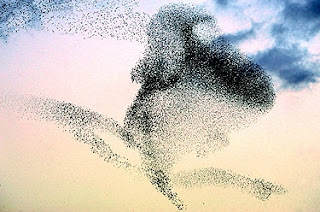Estive
em Roma no Inverno e, preparada que estava para apreciar as artes, a arquitetura,
a gastronomia, a moda, a religião – grandes atrações da cidade - fui
surpreendida por um espetáculo da natureza, a murmuração de estorninhos.
 |
Murmurações de estorninhos sobre Roma, Itália
|
Estorninhos
são passarinhos que, na Europa, após o período de reprodução no Verão, migram
em bando do Norte do Continente em direção ao Sudoeste a partir do Outono. Aparentemente,
Roma é uma Meca neste roteiro, chegando a ser invadida por mais de cinco
milhões dessas aves a cada ano.
Murmuração é como se chama um bando de estorninhos que pode conter de algumas dezenas de milhares a mais de um milhão de indivíduos. Depois de passar o dia dispersos em pequenos grupos, atrás principalmente de insetos em campo aberto, eles reúnem-se no final da tarde para juntos passarem a noite em segurança.
| Murmurações de estorninhos |
O balé executado no céu pelas murmurações, com movimentos e coreografias espetaculares, é uma tática de evasão de predadores, onde o indivíduo indefeso transforma-se num ser grande e extremamente ágil, difícil de ser apanhado, especialmente se evitar permanecer nas bordas da murmuração. Os passarinhos demonstram uma sincronicidade espantosa. A ciência explica que cada um deles fica de olho em outros sete à sua volta, imitando instantaneamente qualquer variação no vôo de seus vizinhos. No mar, as sardinhas fazem o mesmo.
 |
| Murmuração de estorninhos |
Nos tempos atuais em que a sociedade dos humanos passa a se organizar e atuar cada vez mais em rede, o fenômeno da murmuração e da imitação dos estorninhos já é objeto de estudo nos processos de comunicação, disseminação e adoção de ideias e comportamentos coletivos.
Cai
a noite e os estorninhos recolhem-se a suas árvores-dormitório seguindo os
indivíduos que, durante o encontro na murmuração, lhes pareceram mais bem alimentados para, na manhã
seguinte, partir com eles para as áreas de comida mais farta. Como tudo tem um preço, terminado
o espetáculo, a cidade eterna, transformada em enorme poleiro, enfrenta então um
também eterno problema, como dizem alguns, o de lidar com os excrementos dos acrobatas voadores.
Portanto,
estacionar debaixo das árvores durante a noite está fora de questão e ter um guarda-chuva à
mão faça chuva ou faça sol, pode vir bem a calhar, especialmente numa caminhada ao longo do Rio
Tibre: os estorninhos têm predileção pelas árvores que o margeiam. Que o digam os
membros da patrulha da Liga Italiana de Proteção de Pássaros que, ao fim do
dia, vestidos da cabeça aos pés em macacões de plástico, de máscara e munidos de
megafone, tentam espantar os passarinhos das árvores tocando em alto volume,
gritos de socorro da própria espécie. Alguns resistem e os que se vão, apenas
transferem o problema para uma outra árvore na cidade...
 |
| Carro estacionado à beira do Rio Tibre coberto por excrementos. |
 |
| Patrulha da Liga Italiana de Proteção aos Pássaros tentando espantar os estorninhos das árvores às margens do Rio Tibre com a reprodução em alto volume de gritos de socorro da própria espécie. |
 |
| Alguns estorninhos resistem e outros se vão, mas não para muito longe, apenas transferindo o problema para outro lugar. |













